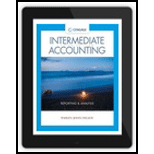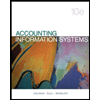
Blackmon Company provides locator services to the city transportation departments. Blackmon’s service involves installing a dedicated hardware transmitter in each city bus. This transmitter provides real-time information to a central logistics center that provides a manager with detailed information as to bus location, speed, current weather, and traffic patterns. The manager can then reroute buses to improve efficiency of operations and increase customer satisfaction. Customers generally sign two separate contracts: one contract governs the sale of the hardware devices, while the second governs the provision of the locator services.
On January 1, 2019, a customer purchased Blackmon’s service by signing a contract for 100 devices for $480,000, the normal selling price. In addition, the customer signed a separate 12-month service contract for $2,000 per month ($20 per month per unit, which is the standard selling price for the service). This amount is billed on a monthly basis, and the customer pays for January service on January 31, 2019. The hardware device can only be used with Blackmon’s services and there are currently no other competitors making devices that work with the Blackmon service. The customer may cancel at any time; however, the amount paid for the device is nonrefundable. The customer is given the right to renew the service contract at the existing rate each December, and the average life of a customer contract is 5 years. The customer takes delivery of the device on January 1, 2019, and begins the locator service on that date.
Required:
- 1. Identify the contract(s) for accounting purposes.
- 2. How many performance obligations exist? When will the performance obligation(s) be satisfied?
- 3. Prepare Blackmon’s
journal entries for January 2019. - 4. Assume that other competitors sell a similar locator service comparable to Blackmon’s. Would this fact change your previous answers?
Want to see the full answer?
Check out a sample textbook solution
Chapter 17 Solutions
INTERM.ACCT.:REPORTING...-CENGAGENOWV2
- Verano, Inc. provides the following financial data for 2023: • • Credit sales during the year: $4,500,000 . Accounts receivable (December 31, 2023): $410,000 Allowance for bad debts (December 31, 2023): $45,000 Bad debt expense for the year: $25,000 Required: What amount will Verano, Inc. report as the net realizable value (NRV) of accounts receivable on its year- end balance sheet?arrow_forwardHi expert please give me answer general accounting questionarrow_forwardWhat is the cost of goods soldarrow_forward
 Intermediate Accounting: Reporting And AnalysisAccountingISBN:9781337788281Author:James M. Wahlen, Jefferson P. Jones, Donald PagachPublisher:Cengage Learning
Intermediate Accounting: Reporting And AnalysisAccountingISBN:9781337788281Author:James M. Wahlen, Jefferson P. Jones, Donald PagachPublisher:Cengage Learning Accounting Information SystemsAccountingISBN:9781337619202Author:Hall, James A.Publisher:Cengage Learning,Business Its Legal Ethical & Global EnvironmentAccountingISBN:9781305224414Author:JENNINGSPublisher:Cengage
Accounting Information SystemsAccountingISBN:9781337619202Author:Hall, James A.Publisher:Cengage Learning,Business Its Legal Ethical & Global EnvironmentAccountingISBN:9781305224414Author:JENNINGSPublisher:Cengage Pkg Acc Infor Systems MS VISIO CDFinanceISBN:9781133935940Author:Ulric J. GelinasPublisher:CENGAGE L
Pkg Acc Infor Systems MS VISIO CDFinanceISBN:9781133935940Author:Ulric J. GelinasPublisher:CENGAGE L Auditing: A Risk Based-Approach to Conducting a Q...AccountingISBN:9781305080577Author:Karla M Johnstone, Audrey A. Gramling, Larry E. RittenbergPublisher:South-Western College Pub
Auditing: A Risk Based-Approach to Conducting a Q...AccountingISBN:9781305080577Author:Karla M Johnstone, Audrey A. Gramling, Larry E. RittenbergPublisher:South-Western College Pub Auditing: A Risk Based-Approach (MindTap Course L...AccountingISBN:9781337619455Author:Karla M Johnstone, Audrey A. Gramling, Larry E. RittenbergPublisher:Cengage Learning
Auditing: A Risk Based-Approach (MindTap Course L...AccountingISBN:9781337619455Author:Karla M Johnstone, Audrey A. Gramling, Larry E. RittenbergPublisher:Cengage Learning





